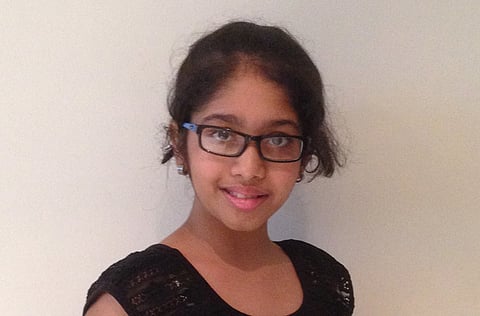Budding student scientist scales new heights
Two of Prerna’s experiments will be launched into space under a Cubes In Space programme

Sharjah: Eleven-year-old Prerna Pai is the only student from the UAE who has got two of her experiments approved for launch into space under a Cubes In Space Programme (CIS) programme for budding young scientists.
The programme invites students from around the world in the age group of 11-14 to devise experimental payloads for space. Around 100 of the selected experiments will be fired into space in a sounding rocket to be launched by CIS on June 26.
According to the CIS website, a sounding or research rocket carries scientific instruments into space to take measurements along a non-orbiting and parabolic path (trajectory). This means that the rocket flies up and then back down to Earth along an arced path. Seventy-five American students and 25 students from the rest of the world were selected under the programme.
CIS Programme in May in partnership with Rubik Learning Initiative, idoodle software and the Colorado Space Grant Consortium’s RockSat-C programme.
Prerna, a seventh grader at Sharjah’s Delhi Private School, has been regularly participating in Nasa student activities such as studying the solar flare last year, is on the Nasa mailing list.
“I had to think a lot when I learned about this contest and sent them [CIS] many proposals. My science teacher has always encouraged me to think out of the box and that inspired me. Once my ideas were selected, CIS sent me a kit into which I had to place my experiments and mail it to them. I was so thrilled by the news that I even dashed off a thank-you note to CIS,” says the who plans to be a scientist when she grows up.
Prerna submitted two experiments that she called ‘To stick or not to stick’ and ‘time and pressure’.
The first experiment is about studying the manner in which different adhesives are likely to behave in space in the absence of atmospheric pressure. For this, Prerna used a thermocol cube of 12 pieces in which each corner was stuck using a different kind of adhesive such as modelling clay, wax, cello tape, metal wire, thread, school glue and super glue. The experiment focuses on how each kind of adhesive acts and whether the sides of the cube will open up or further stick depending on the nature of the adhesive.
The second experiment involves two tiny bottles — one made of plastic and the other of glass — sealed with a modelling clay cork and placed in a cube. The experiment will focus on how the bottles react to lack of atmospheric pressure: Will they disintegrate, get damaged or remain intact?
For the second part of this experiment that involves time, Prerna took two identical sports watches set precisely to the same time. She took off the straps of one watch and stuck the dial to the side of the cube that will be sent into space, while the second watch remains with her. “When the watch returns from space, I will check if it gets slower or faster so as to establish whether time moves faster or slower in space going by Einstein’s theory of relativity,” she explained.
Once the experiments are back from space and mailed to her, Prerna intends to begin research on the effects, film the results and mail them back to CIS.
For now, the budding scientist is waiting with bated breath for June 26, when the sounding rocket will be launched into space.
Sign up for the Daily Briefing
Get the latest news and updates straight to your inbox



